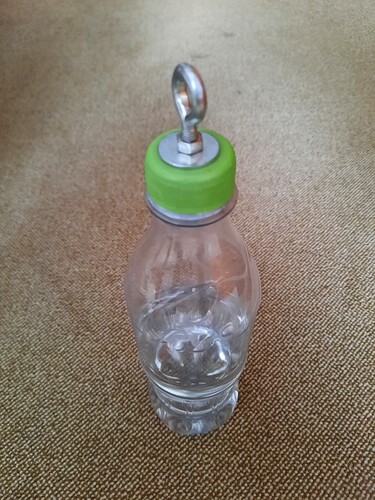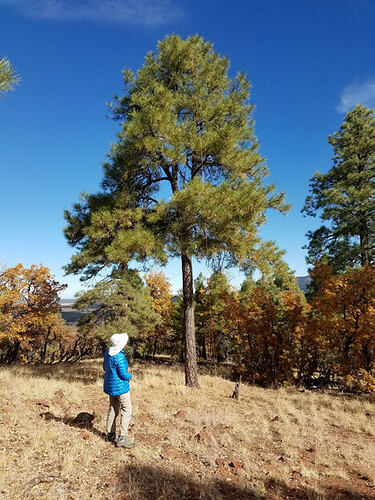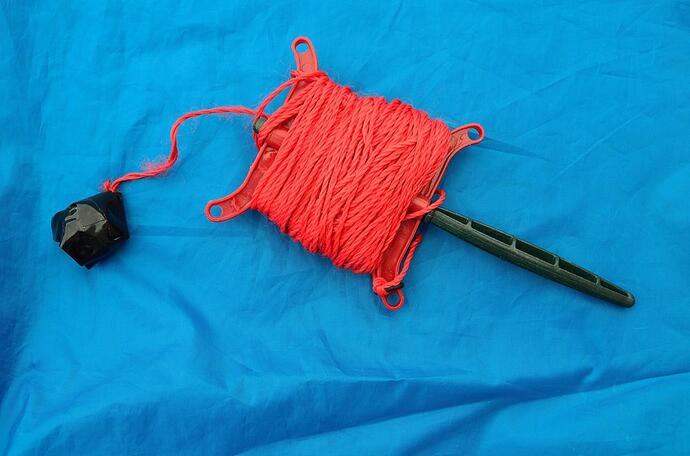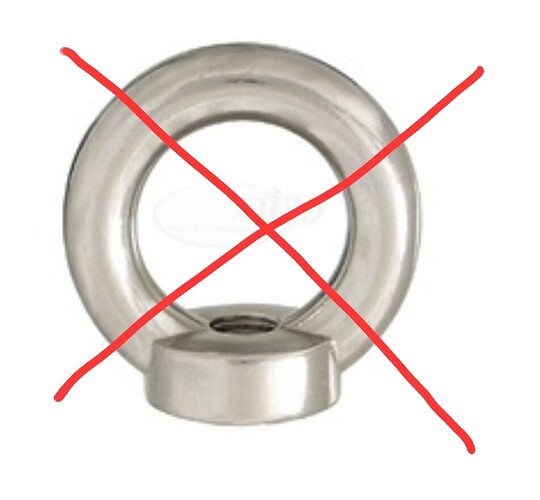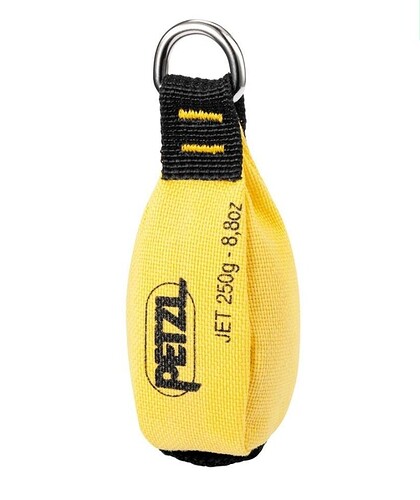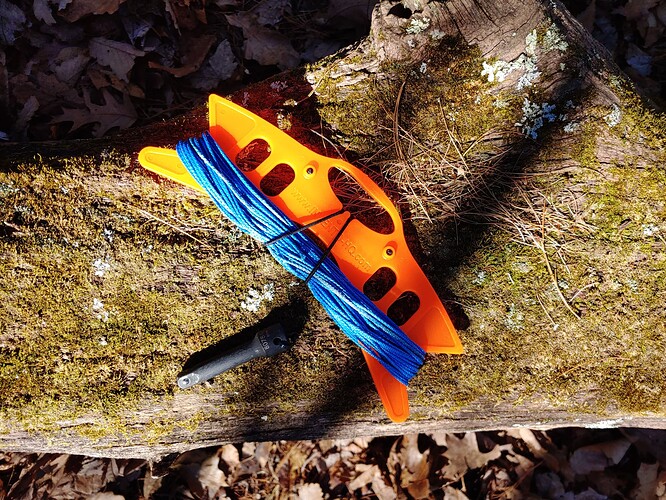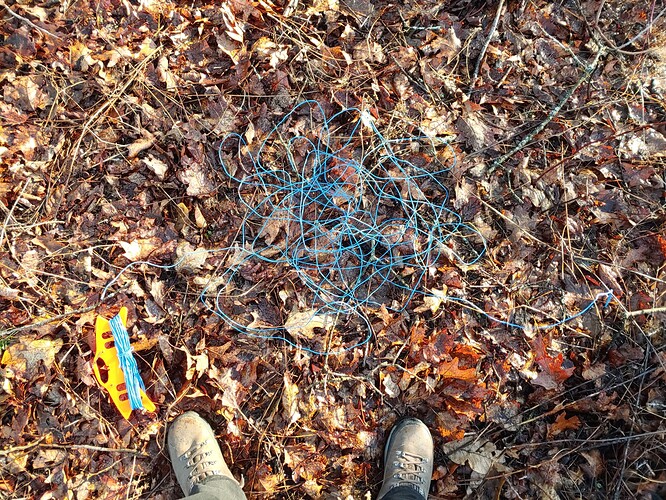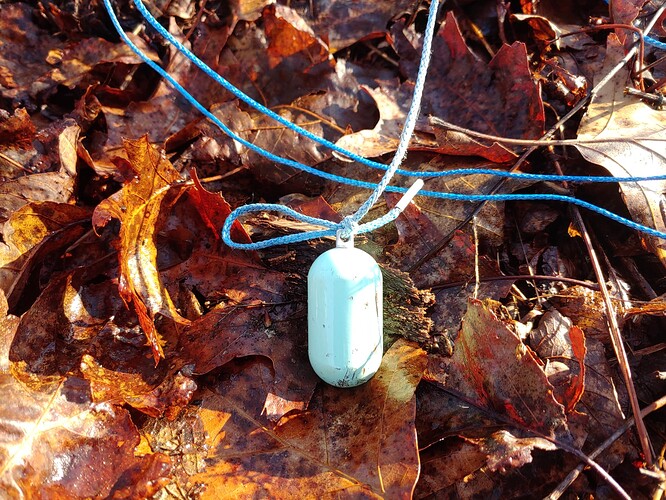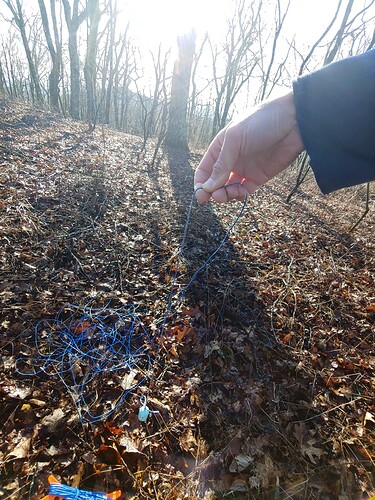I recently helped a friend get a long wire up into some trees. I used my preferred method of a golf ball with a screw eye only this time I had the luxury of a 12ft carp rod with 20lb braid 
I certainly don’t want to lose my multitool, but I think you can minimize the risk with a bit of technique. I have been using a proper arborist’s throw bag and slick line for many years to get my antennas and other things up into the trees and I have learned a few things. Rarely have I had an issue with the line wrapping around a branch when throwing a bag. It is far more likely to happen when pulling the bag back through the branches for another throw and only when pulling the bag back too quickly.
From my casual observations, in order for the the throw bag to wrap around a branch when throwing, it must still have sufficient velocity and the line must be taut causing the bag to change course and get rid of the energy. If the line is loose, the throw bag will simply continue on its trajectory until gravity takes over. Hanging an antenna for an activation is a more simple exercise involving a lower branch but these tips still applies to trying to get a line high up in a tree. Keep in mind that I am typically working with hardwood trees with a more open understory on an activation.
-
Don’t overthrow - I want gravity to take over as soon as the throw bag clears the branch that is my target. If I miss the branch it will fall to the ground or a lower branch for easy retrieval. Since I am dealing with shorter heights and a fixed length of line, I will often avoid pulling the bag back through the trees for another throw if there are a lot of branches and just let it drop to the ground and pull the line from the other side. If you are pulling a throw bag back through the branches, go very slow as the bag approaches a branch. That is when the bag will typically start to swing like a pendulum and gets wrapped around a branch.
-
Have plenty of loose line - I use around 40-50’ of slick throw line for my bear bag/SOTA needs with a small s-biner on each end. As I mentioned before, it is important for the line to not get taut before gravity takes overs so make sure that the line can spool out easily. I clip the s-biner on the near-end of the line to one of my belt loops. I learned this tip after watching far too many perfect throws end with the rest of the line following the throw bag over the branch!
I would say that my biggest issue when using a throw bag is not settling for my first throw and instead trying repeatedly to get the line over that ‘perfect’ branch. Maybe using a pendulum swing for my throw helps me create a better trajectory, but I have a bad shoulder and throw like a sissy anyway so it is my only real option. ![]() YMMV and all other disclaimers applied but unless I know that the summit will require a mast, I am happy with the throw bag and line.
YMMV and all other disclaimers applied but unless I know that the summit will require a mast, I am happy with the throw bag and line.
73, pat - ki4svm
Hello all,
For most activations, use 1/8" neon orange or yellow arborist throw line, with 14 oz. shaped weight.
Both are pricey, but work well; cheap substitutes yield frustration.
Bag is a mini-throw line holder, about 6" in diameter and 8" high; holds 150 ft. of line, which will do fine for 50-ft. trees, with extra line to adjust for distance between trees, etc…
Use reverse toss; with some practice, your accuracy will amaze you. See pix, and zoom in to see the orange line.
Best, Ken
Yesterday, I just tied the wifes water bottle onto the end of my string, and tossed it over the branch that was just above head height.
Pity about the water bottle detaching itself from the string and disappearing into a kiekie thicket, where it will remain hidden for ever, even though it was only about 1 metre away.
tldr: someone elses water bottle is best
Perhaps in future, I should tie a fixed loop of string properly around the bottle neck before I start, and then tie the antenna string to that instead of the half-arsed fail I do every time.
Whenever there are trees in my activation zone (and usually there are), I use a 80g fishing weight (sinker) bound to a light red mason’s cord (see picture). It fits very well in my backpack and I do not need to carry a bulky +300g pole with me. 80g are a good compromise in terms of weight and is usually sufficient that the sinker gets down to the ground.
I always toss the weight with one arm from below and usually reach heights of around 8 - 10 metres (26 - 32 ft). This height is sufficent to make contacts. After completing the activation, I take down the cord from the sinker side so that the loose end goes over the branch. This avoids that the sinker weight wraps around a branch.
At the beginning, I also tried a slingshot, but I realised it is not really necessary and only adds additional weight to the backpack. I try to be as light-weight as possible on my trips.
Excuse me as I lay my gravedigger shovel down for resurrecting this zombie thread, but felt this was worth adding if folks are looking for a throw line bag. I just bought one today - I already have the same Brabantia one for pegs so know it’s decent enough, thus bought a second one.
A lot of the ones I’ve seen on Amazon etc don’t look to be waterproof or are made of cheaper materials? On the other hand some can be a bit overpriced. I think I saw one called Stein or something which was 50 quid. Madness - unless you are a climber or something then of course safety and quality are of the utmost.
Anyways, save yourself a few quid and use a peg bag. The Brabantia one is decent quality, waterproof outer (minus the drawstring) and has a carabiner and a drain hole in the bottom you could feed a line through and knot it off.
Or save even more and just use one of these:
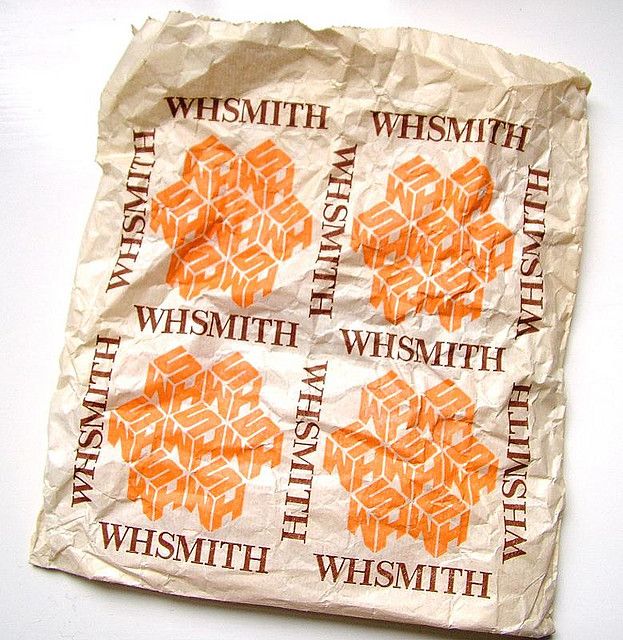
Or this:

I use an old sock… ![]()
![]()
I REALLY hope we’re still talking about throw lines… ![]()
So do I. Its good to use one made of natural fabric, so we dont leave plastic traces in the trees, if it decides to stay up there. On site I fill it with gravel or similar stuff found there. Its not necessary to carry up the weight of a weight. ![]()
That occours easily, when the line ist stopped or even pulled back while the weight is flying over the branch. Always let the line run out freely.
I never bind the throwing line to the weight. It has a small loop attached to it and I run the line through. So I have a double line which I can pull out, if the weight is braked by the line and does not find its way down again between the branches and twigs. Freed from the line it will always come down.
The mast is used on higher mountains lacking trees in the AZ.
73, Johannes
For a few years I used a ring nut. Very dangerous ![]() , I’m glad nothing happened to me. The eyelet also tends to get caught in the branches.
, I’m glad nothing happened to me. The eyelet also tends to get caught in the branches.
Then I got over my stinginess and finally bought a professional Baumsteiger throwing bag. Avoid the cheap things that cost a few euros, they break straight away.
I grab the rope at a distance of approx. 40cm from the weight and swing from bottom to top.
73 Chris
Based on K4SWL/qrper.com recommendations, I’ve been using the following for a couple years:
- Marlow Excel Throw Line 2mm X 164' (50M) cut into 60’, 90’ (two options for throwing), and a couple short lengths
- https://www.wesspur.com/THR233-arborist-throw-weight (much less bright and shiny after all this time of landing in dirt)
Wesspur has a cheap throw line bag; don’t get it! I found it very cheap, smelling of low quality plastic, and it started delaminating after I tried to wash it to get rid of the offgassing. Now its seams are failing and it doesn’t even hold things reliably. I need to salvage the stainless rings from it and move on…
I was hoping for their neon green, but stock issues mean I’m getting Arborist Throw Line - Orange Reflective – Atwood Rope MFG soon as a new addition to my kit. It might end up serving more as a decent-visibility extension for dipole/doublet/elevated-radial duty; TBD.
Edit: I think I picked up this site in another thread; they’ve got a great page on trees (and another on throwing and yet another on ropes for antennas): Using Trees as Antenna Supports – Practical Antennas
Anyone recommend some good durable cord from Amazon, or any IOSS-friendly or EU-based store?
Given the time of year and sub-par weather, I’m more inclined to punt an antenna up in to a tree rather than faffing around setting up a mast.
Slightly OT but is that DX Wire from that shop in Germany any use?
Reason I ask is I’ve a kite i want to build a random wire for and tune multi band. Also keen to make some resonant wire antennas but not sure what cable to buy or what kits to build an antenna are any use (and IOSS/EU friendly store).
Anything that can be booted up in to a tree or put on a 7m or 10m mast as a vertical is preferred.
Thanks all.
I always carry a 7 meter fishing pole mast that weighs about 9 oz. And I set up a random wire antenna in an inverted L. If there are trees on the summit, I use the mast with tiny plastic carabiner to loop the wire over a branch. I can usually get the wire up about 30 feet: plenty high enough on a summit. Then I walk the mast out until the wire is horizontal. If I’m lucky, I can stick the mast in a bush or lean it into another tree. Or I can use a few rocks to hold it. I doesn’t take much to hold the mast up because you’re not pulling on it much to get it horizontal. On calm days I just lean the mast so it balances by the pull of the wire. To prevent the transformer end from going up the tree, I always fasten the end with the transformer and counterpoise to a low branch or to my pack.
If no tree, then I use the mast and walk the end out and tie to a bush or to a hiking pole wedged on rocks. Still in inverted L/sloper L. Got this idea from KX0R and KT5X.
After many years of carefully hoarding different sorts of braided rope for throwing purposes, my favorite (at least here in the US) is braided mason’s twine, sold in most DIY shops. It used to be that mason’s twine (used for laying bricks in straight rows, etc.) was always twisted, which tends to snag on the bark, especially as it gets used. But now the braided type is available in many stores, often in bright colors. Bright pink shows up very well in the videos!
And thanks to @WN1C for posting the links to my site at PracticalAntennas.com. The specific page is here: Throwing Buckets - PracticalAntennas.com
Hello Dale, welcome to the fraternity.
Geoff vk3sq
I hang my antenna from trees on 99% of summits. What I use with success:
Braided arborist throw line, diameter 1.75 mm, length 60 to 100 ft = 18 to 30 m. The blue has good visibility in all seasons. Store the line wound in a figure-eight on a SOTABeams winder.
Unwind the line into a pile in a spot free of twigs and briars. Unwinding can be done quickly with practice. Grasp the winder’s handle loosely with thumb and forefinger so the winder can wobble as you pull the string straight off with the other hand.
Don’t disturb the pile of string before you throw or you’ll cause it to tangle.
Tie on a 5 oz = 150 g fishing sinker. This is the one I use. It’s snag-resistant, lead-free and comes in an eight pack. Keep a couple extras and share the rest with your SOTA friends.
Notice the white heat shrink tubing which prevents the end of the string from fraying. Melting the cut end of the string works too, but this creates a mushroom which doesn’t fit easily through the small eyelet of these sinkers.
Obviously the sinker is hard, so take care not to throw it on your own head or anyone else’s.
An arborist throw weight (a small canvas bag filled with lead shot) works too, but most are 10 to 16 oz, which is heavier than necessary, and their metal ring poses some risk of getting snagged in the tree.
To throw, grasp the string above the weight with one hand. Swing the weight underhanded back and forth several times as you align the plane of the pendulum with your target. Visualize the weight going over the limb just as you release.
Practice is good. I often get the line where I want it on the first throw, but that comes with experience.
If you need to make another throw, don’t pull the weight back up through the tree. Untie the weight before pulling the line out, or pull the other end of the line up through the tree.
When you pack up, winding the line in a figure-eight prevents twisting it which makes it easier to handle. The figure-eight motion can be done quickly with practice.
Even in Appalachia with dense tree coverage, I prefer the mast. It’s easier for me to sneak the antenna wire into gaps in the spruce/firs on the high peaks. On the balds, there are no trees to speak of. In the hardwood forests, I can simply lean the mast against the tree limb of my choosing.I get more flexibility in deployment options than a throw line without the weight penalty- it’s a breakeven.
The only downside is that I have found the really nice carbon masts that pack down small will detune my antenna when I try to run the sloping 7/L configuration so I default to basic slopers on high bands and inverted V on the lower bands.
I agree @W4AQ Joe. I do the same things as you here in Maine/NH but I use the SOTABeams 13’ fiberglass pole. Easy deployment in the spruce and fir for a 40m EFHW.
Vy 73 de Jonathan “JB”
